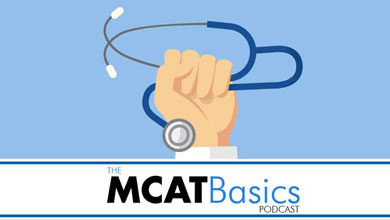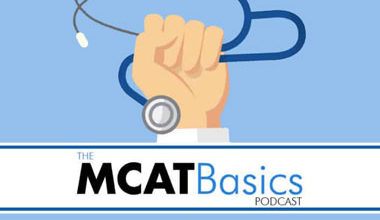Sam reviews DNA mutations and DNA repair for the Bio/Biochem section of the MCAT. He outlines the causes and types of mutations and then dives into repair mechanisms.
- [02:10] Definition of DNA Mutation
- [02:40] Causes of DNA Mutation
- [12:00] How Mutagens Alter DNA
- [16:10] Inborn Errors of Metabolism
- [18:32] Categorizing Mutations
- [22:03] Where Mutations Occur
- [30:03] Chromosomal Mutations
- [32:25] Substitution Mutations
- [36:01] DNA Repair Mechanisms
What Causes DNA Mutation?
A mutation is defined as an error in a DNA sequence. This can happen either during replication or outside of replication.
During replication: Although DNA polymerase uses a template to synthesize new strands, it can still make mistakes. The enzyme makes an error approximately 1 in every 100,000 nucleotides. Another phenomenon that can occur is replication slippage where the DNA polymerase slips off the template strand. This only happens at repeated sequences within the DNA. The newly formed strand creates a loop because the outer most repeated sequence shifts on the complementary strand and forms a base pair with that part. Then DNA polymerase rebinds to the template strand and produces a daughter strand, with the loop remaining still throughout the process. Slipped strand mispairing can result in duplicated repeats. To help you visualize this better, you can watch this explainer video on YouTube.
Mutations that do not occur during replication: These mutations are caused by mutagens. Mutagens are agents that cause DNA mutations. Meanwhile, carcinogens are agents that cause cancer. Certain compounds can mutate DNA but won’t necessarily result in cancer. The flipside is also true, there are carcinogens that don’t cause DNA mutation. For the MCAT, it’s important to know the difference and to be aware of where they overlap
How Mutagens Alter DNA
There are three kinds of mutagens:
- Radiation (UV light, gamma rays)
- DNA reactive chemicals (ROS, benzene, ethidium bromide)
- Metals (chromium, nickel, arsenic)
All of these can act in different ways to cause DNA mutation. Mutagens can change the identity of single bases and break strands of DNA. It can also create DNA adducts where pieces of DNA are covalently bonded to a chemical. Finally, mutagens can cause interstrand crosslinks where two bases from complementary strands are covalently linked together due to DNA damage. All of these have negative implications for transcription and replication.
Categorizing Mutations
By their effects on an organism
A mutation can be classified according to its effects on an organism. An advantageous mutation increases the chances of reproductive success while deleterious mutations have the opposite effect. Neutral mutations have no significant effect on an organism’s reproductive fitness.
By where they occur
For the MCAT, it’s also crucial that you know how to classify mutations based on where it occurs. Here are terms that you need to be familiar with:
- Random mutation – Mutations that occur outside of translation or transcription.
- Translation error – Errors that arise when mRNA is converted into protein. Errors are not always due to mutation but can have the same effects as one. If a wrong amino acid is incorporated into a protein, protein activity may be affected.
- Transcription error – Any error in which wrong mRNA is produced from a correct genetic sequence.
- Base substitution – Replacement of a nucleotide in DNA/RNA with another nucleotide, causing point mutations where a single base pair is altered.
- Addition/Insertion – One or more nucleotides are added to a DNA strand. This can result in frameshift mutation.
- Deletion – One or more nucleotides are taken out of DNA. This can result in frameshift mutation.
- Frameshift mutation – Reading frame of a gene is shifted in some way (usually from an insertion or deletion). This leads to the incorrect triplet codon sequence.
By chromosome (chromosomal mutations)
- Inversion – A part of the chromosome breaks off, flips around, and reattaches back
- Translocation – A chromosome swaps bits of genetic material with another chromosome
- Robertsonian Translocation – Two acrocentric chromosome are stuck together to make a larger chromosome
By their effect on proteins
Finally, mutations can be classified depending on the effect it has on the amino acid sequence of a protein.
- Missense Mutation – Results in change to amino acid sequence
- Nonsense Mutation– Results in premature stop codon
- Silent Mutation – Results in no change to the amino acid sequence
DNA Repair Mechanisms
Just like mutations, DNA repair can happen either during replication or outside of replication. DNA polymerase synthesizes new DNA in the 5’ – 3’ direction. 3’- 5’ exonuclease activity or the proofreading activity of DNA polymerase allows the enzyme to go back, remove mismatched bases, and put in the correct ones. Note that the enzyme that made the error is not always the same enzyme that does the repairs.
Mutations that go undetected during replication or are the result of a mutagen can be repaired outside of replication. Here are the five repair mechanisms that may be applied:
- Direct Reversal – Enzymes can directly come and fix the affected region without breaking the phosphodiester DNA bond.
- Mismatch Repair (MMR) – This mechanism only occurs at newly synthesized daughter strands after replication. It fixes mismatched bases as well as insertion and deletion loops that are results of replication slippage.
- Base Excision Repair (BER) – Corrects single base distortions that don’t alter the DNA too much.
- Nucleotide Excision Repair – Deals with bulky, distorting damage to the DNA. A 10-20 long nucleotide strand is removed both upstream and downstream from the damaged site. Gap is then filled with correct nucleotides and sealed with ligase.
- Interstrand Crosslink Repair (ICR) – This repair mechanisms involves two rounds of nucleotide excision repair. A round of repair is conducted on each strand.
Repair of DNA breaks
Mutagens can cause single or double strand breaks.
Single Strand Break Repair – A team of enzymes come and seal the DNA back together.
Double Stranded Break Repair – There are two mechanisms to know for this:
- Homologous Recombination Repair – A homologous sister chromosome is used as a template to repair the break. It is a high fidelity process.
- Non-homologous Enjoining – This mechanism does not use a template, making it a lower fidelity process. The ends on each side of the break are stuck back together. Sometimes, genetic material is lost.

